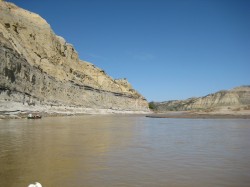Last Word | April 5th, 2017

A thousand trucks a day. That’s what Billings County Commission Chairman Jim Arthaud bragged to the Dickinson Press one day, a number of years ago, when he was asked how many vehicles would use a new bridge over the Little Missouri River north of Medora.
A lot of water has flowed beneath that proposed bridge since 2012, the last time the public was invited to consider a draft Environmental Impact Statement (EIS) for the project. He might lower that estimate by a few hundred today.
As I mentioned in an earlier article, a new draft of that EIS is ready to go and we’ll get a look at it in the next couple of months. KLJ Engineering has caught everyone by surprise, including, I think, the Billings County Commission, by its proposed location of the new river crossing on the Short Ranch, just 15 miles or so north of Medora.
Everyone’s asking, “Why there?”
We’ll find out when we actually read the document, but it’s important to remember that what is driving the suggested location is an Environmental Impact Statement. And that means just what it says. What will be the impact on the environment of a new bridge across the Little Missouri River desired by the Billings County Commission?
The Environmental Impact Statement is required by the National Environmental Policy Act (NEPA) because Billings County is requesting that the federal government pay a significant portion of the cost of the project, and because the construction of the bridge may impact a federal waterway, the Little Missouri River.
The NEPA was signed by President Richard Nixon in 1970. It also created one of the biggest bogeymen in federal government, the Environmental Protection Agency, a much despised agency in western North Dakota. My friend Dave Pieper, retired Dakota Prairie Grassland supervisor, points out that it was oil that brought this law into existence. Congress and President Nixon acted to begin protecting our environment in part in response to the public outcry after the 1969 Santa Barbara oil spill.
In a letter to the editor a few years ago, Dave summed it up nicely: NEPA has two primary goals: 1) It obligates federal agencies to consider every significant aspect of the environmental impact of an action before proceeding with it, and 2) It ensures that the agency responsible for the action will inform the public what the action is, and that it has considered environmental concerns in its decision-making process. It is a law of public disclosure.
The Federal Highway Administration (FHWA), which gets final sign-off on this project, is requiring Billings County to prove that there are sufficient environmental safeguards built into this project to satisfy the requirements of NEPA before it starts signing checks, which could run as high as $15 million -- higher if new roads have to be built to accommodate the traffic the bridge will enable to cross through the Badlands.
We’ll know more when we read the document, but it appears as if KLJ, hired by Billings County to clear the way for federal funds, is proposing what they believe is the least environmentally damaging location to put the bridge. I’m told the cost to the county, which must pay for the EIS, is now approaching $2 million, about double what I cited in my earlier story. Luckily, Billings County can afford it. Thanks to oil tax revenue over the past 40 years, it is perhaps the richest county, per capita, in the state.
There are no such things as federal “earmarks” for projects such as this anymore, so federal money for the project will have to come from North Dakota’s annual allocation of federal highway funds. So when, or if, the project gets the green light as a result of the EIS , the acceptance of the proposed location by Billings County, and approval by the FHWA, then officials at North Dakota’s DOT will have to decide if the money should be spent there, or on other more needed or worthy projects elsewhere in the state.
Ultimately, I suppose, Governor Doug Burgum will have the final say in when, or if, the project gets built.
Soon there will be a series of public meetings, testimony will be taken, both written and oral, and then the final EIS will be written and will need to be accepted by the County Commission, which will present it to the FHWA, along with the request for funding.
From what I can tell, if, in the end, a bridge is built at the Short Ranch, the biggest beneficiaries will be a few local ranchers. Because of its proximity to I-94, it’s not likely to become a big truck route. To get to the bridge from Highway 85 is a circuitous route, through some pretty tough Badlands terrain.
We’ve been told that the anticipated speed limit on the roads approaching the bridge is 35 miles per hour. When those big old trucks, loaded with oil or water, start up some of those hills at 35 mph, they’re gonna be going backwards by the time they get halfway up. The next time they’ll take the I-94.
The stated goal of this project at the outset was to move traffic from Highway 85 to Highway 16 without going all the way to the Interstate. It’s my opinion that this proposal does not meet that goal.
We need to remember that originally, the County commissioners proposed to build the crossing right beside the Elkhorn Ranch, which was about halfway between the two existing bridges and which, with good outlets to both highways, did accomplish the goal. But the firestorm of opposition to putting it beside the historic Roosevelt ranch stopped that idea dead in its tracks. That’s what sent KLJ and the county scrambling, and this new EIS is the result.
I hope this is a deal killer. We don’t need a thoroughfare for trucks through the Little Missouri River valley, and no one other than the oil industry, fronted by Arthaud, was asking for one. Until he sold his trucking business a few months ago, Arthaud would have been one of the major beneficiaries of the bridge.
Of course, there was an oil boom going on then, and there were a lot more trucks on the road. With Arthaud out of the picture, and the oil boom gone bust, we’ll see how much enthusiasm there still is for this project.
I, and many, many other people concerned about the Little Missouri River Valley, hope the enthusiasm is gone, and that this really bad idea gets thrown into the shitpile of busted dreams and scorched-earth plans somewhere on a back road of oil country, never to be seen or heard from again.
[You can read more of Jim’s writings about the Bad Lands at theprairieblog.areavoices.com]
June 19th 2025
June 19th 2025
April 27th 2025
April 17th 2025
February 28th 2025
__293px-wide.jpg)

__293px-wide.jpg)
__293px-wide.jpg)

